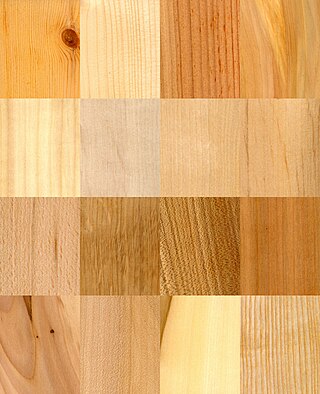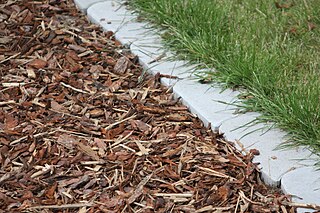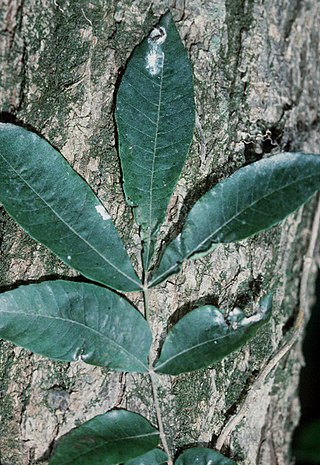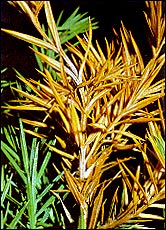
Wood is a structural tissue found in the stems and roots of trees and other woody plants. It is an organic material – a natural composite of cellulose fibers that are strong in tension and embedded in a matrix of lignin that resists compression. Wood is sometimes defined as only the secondary xylem in the stems of trees, or more broadly to include the same type of tissue elsewhere, such as in the roots of trees or shrubs. In a living tree it performs a support function, enabling woody plants to grow large or to stand up by themselves. It also conveys water and nutrients between the leaves, other growing tissues, and the roots. Wood may also refer to other plant materials with comparable properties, and to material engineered from wood, woodchips, or fiber.

Quercus kelloggii, the California black oak or Kellogg oak, is an oak in the red oak section native to western North America. Although genetically separated from them for more than 20 million years, its leaves are remarkably similar in appearance to several other members of the red oak section including the red oak and the black oak found in eastern and central North America.

Picea mariana, the black spruce, is a North American species of spruce tree in the pine family. It is widespread across Canada, found in all 10 provinces and all 3 territories. It is the official tree of the province of Newfoundland and Labrador and is that province's most numerous tree. The range of the black spruce extends into northern parts of the United States: in Alaska, the Great Lakes region, and the upper Northeast. It is a frequent part of the biome known as taiga or boreal forest.

A mulch is a layer of material applied to the surface of soil. Reasons for applying mulch include conservation of soil moisture, improving fertility and health of the soil, reducing weed growth, and enhancing the visual appeal of the area.

Alnus rubra, the red alder, is a deciduous broadleaf tree native to western North America.

Quercus virginiana, also known as the southern live oak, is an evergreen oak tree endemic to the Southeastern United States. Though many other species are loosely called live oak, the southern live oak is particularly iconic of the Old South. Many very large and old specimens of live oak can be found today in the Deep South region of the United States.

Pulpwood can be defined as timber that is ground and processed into a fibrous pulp. It is a versatile natural resource commonly used for paper-making but also made into low-grade wood and used for chips, energy, pellets, and engineered products.

Pinus elliottii, commonly known as slash pine, is a conifer tree native to the Southeastern United States. Slash pine is named after the "slashes" – swampy ground overgrown with trees and bushes – that constitute its habitat. Other common names include swamp pine, yellow slash pine, and southern Florida pine. Slash pine has two different varieties: P. e. var. elliottii and P. e. var. densa. Historically, slash pine has been an important economic timber for naval stores, turpentine, and resin. The wood of slash pine is known for its unusually high strength, especially for a pine. It exceeds many hardwoods and is even comparable to very dense woods such as black ironwood.

Arbutus menziesii or Pacific madrone, is a species of broadleaf evergreen tree in the family Ericaceae. It has waxy foliage, a contorted growth habit, and flaky bark.

Coarse woody debris (CWD) or coarse woody habitat (CWH) refers to fallen dead trees and the remains of large branches on the ground in forests and in rivers or wetlands. A dead standing tree – known as a snag – provides many of the same functions as coarse woody debris. The minimum size required for woody debris to be defined as "coarse" varies by author, ranging from 2.5–20 cm (1–8 in) in diameter.
Silviculture is the practice of controlling the growth, composition/structure, as well as quality of forests to meet values and needs, specifically timber production.

Clearcutting, clearfelling or clearcut logging is a forestry/logging practice in which most or all trees in an area are uniformly cut down. Along with shelterwood and seed tree harvests, it is used by foresters to create certain types of forest ecosystems and to promote select species that require an abundance of sunlight or grow in large, even-age stands. Logging companies and forest-worker unions in some countries support the practice for scientific, safety and economic reasons, while detractors consider it a form of deforestation that destroys natural habitats and contributes to climate change. Environmentalists, traditional owners, local residents and others have regularly campaigned against clearcutting, including through the use of blockades and nonviolent direct action.

Forest ecology is the scientific study of the interrelated patterns, processes, flora, fauna and ecosystems in forests. The management of forests is known as forestry, silviculture, and forest management. A forest ecosystem is a natural woodland unit consisting of all plants, animals, and micro-organisms in that area functioning together with all of the non-living physical (abiotic) factors of the environment.

Carya tomentosa, commonly known as mockernut hickory, mockernut, white hickory, whiteheart hickory, hognut, bullnut, is a species of tree in the walnut family Juglandaceae. The most abundant of the hickories, and common in the eastern half of the United States, it is long lived, sometimes reaching the age of 500 years. A straight-growing hickory, a high percentage of its wood is used for products where strength, hardness, and flexibility are needed. The wood makes excellent fuel wood, as well. The leaves turn yellow in Autumn.

Carya aquatica, the bitter pecan or water hickory, is a large tree, that can grow over 30 metres (98 ft) tall of the Juglandaceae or walnut family. In the American South it is a dominant plant species found on clay flats and backwater areas near streams and rivers. The species reproduces aggressively both by seed and sprouts from roots and from stumps of cut trees. Water hickory is a major component of wetland forests now in the south eastern US, because of the selective cutting of more desirable tree species for the lumber industry. It is considered important in cleansing drainage waters since the plants slow water flow during flooding, allowing sediments to fall out of the water column. This tree species is tolerant of wet soils but grows best on well draining soils near rivers and other water ways.
Rubberwood is a light-colored medium-density tropical hardwood obtained from the Pará rubber tree, usually from trees grown in rubber plantations. Rubberwood is commonly advertised as an "environmentally friendly" wood, as it makes use of plantation trees that have already served a useful function.

Didymascella thujina is an ascomycete fungus in the family Helotiaceae. D. thujina causes cedar leaf blight, a leaf disease, on western red cedar and white cedar (T. occidentalis).

Phomopsisblight of juniper is a foliar disease discovered in 1917 caused by the fungal pathogen Phomopsis juniperovora. The fungus infects new growth of juniper trees or shrubs, i.e. the seedlings or young shoots of mature trees. Infection begins with the germination of asexual conidia, borne from pycnidia, on susceptible tissue, the mycelia gradually move inwards down the branch, and into the main stem. Management strategies mainly include removing and destroying diseased tissue and limiting the presence of moisture on plants. Junipers become resistant to infection as they mature and the young yellow shoots turn dark green. Preventive strategies include planting only resistant varieties and spraying new growth with fungicide until plants have matured.

Rivière-du-Moulin Ecological Reserve is a strictly protected ecological reserve in the province of Quebec, Canada. It contains a stand of mature eastern hemlock trees, with some white pines, a combination that was once common in Quebec but has almost disappeared due to forestry and farming.
Oak regeneration failure is a woodland phenomenon whereby insufficient oak (Quercus) seedlings and saplings are recruited into the canopy to replace dead mature oaks. The result is a local decline in oak numbers while other more shade-tolerant trees such as maple, lime, and ash may become more prominent. Oak regeneration failure has been observed across Eastern and Midwestern forests in the United States as well as in Europe.

























